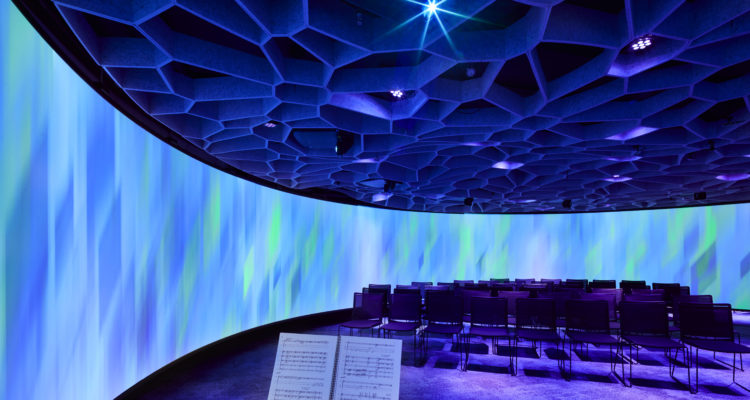Audiences in the Seattle Symphony’s new Octave 9 Raisbeck Music Center are surrounded by a CFRP-backed circular enclosure that immerses them in a multi-sensory experience of live music, surround video projection and responsive audio and acoustics. Opened in February 2019, the 2500-square-foot music center is designed for intimate performances, educational programs and community engagement offered by the symphony. The CFRP panels, which were formed from repurposed carbon fiber epoxy prepreg scrap and finished with black walnut veneer, were chosen as a lightweight alternative to acrylic.
“The issue that we came up against was that we had specified an acrylic panel – something like a 3/8-inch thick – and it was going to be really heavy,” explains Scott Crawford, Octave 9 project designer with LMN Architects in Seattle. He recalled seeing a CFRP/wood veneer sample and thought this would be a way to include wood that matches the hall’s existing woodwork, while significantly reducing the weight of the entire structure.
Weight was especially important because the music center features 13 movable sections, which allows the symphony to adapt the space and sound by using a few panels or creating a nearly complete circle. Each section comprises a CFRP-backed black walnut veneer exterior panel and an interior acrylic video screen panel. The panels are mounted on either side of a wheeled steel frame so they can be easily moved.
The panels are the creation of the Composite Recycling Technology Center (CRTC) in Port Angeles, Wash., a nonprofit organization dedicated to developing products from advanced composite scrap material. Such material is abundant in Washington, with approximately 900 tons of carbon fiber composite manufacturing waste sent to landfills annually, according to the Washington Department of Ecology. CRTC estimates that includes approximately 500 tons of uncured carbon fiber prepreg.
CRTC procures CFRP prepreg from a handful of companies, including Toray CMA and Boeing. The scrap is generated when manufacturers clear expired prepreg from their freezers or reject material because of cosmetic flaws, such as a missing a fiber or a slice in the roll. Material suppliers also discard partial rolls of CFRP prepreg left over at the end of production runs. “That’s pretty common, especially with full-width rolls,” says Erik Poulin, CRTC materials process engineer. “At the end of a bunch of production runs, they’ll accumulate the leftovers onto one roll and then that will get scrapped.”
Poulin says that reclaimed prepreg, such as that used in the Octave 9 project, retains most of its properties, cures well and generally looks and acts like virgin material. “As long as you don’t need the paper trail like aerospace requires, it’s still a really beautiful material,” he says.


